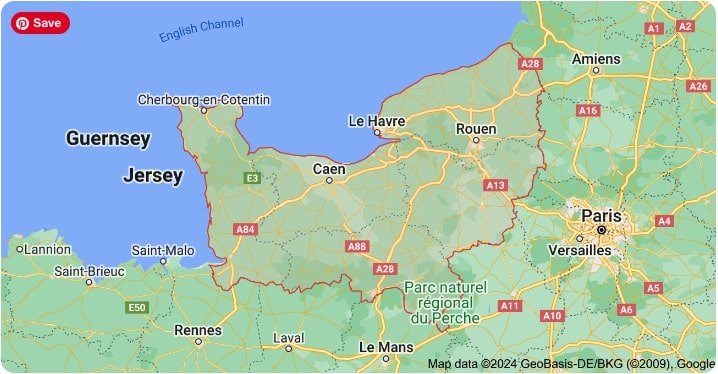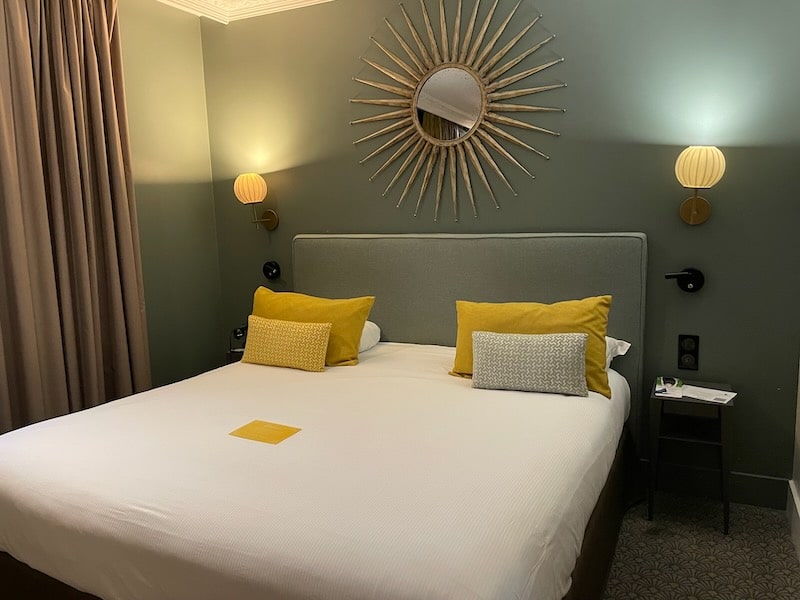Unsure about your French table manners? Click Here to download > > How to avoid these 10 food etiquette mistakes !
- Home ›
- Destinations ›
- Normandy ›
- Things To Do In Rouen
12 Things To Do In Rouen, Normandy That Will Enrich Your Culture
Published 31 March 2024 by Leyla Alyanak — Parisian by birth, Lyonnaise by adoption, historian by passion
The city of Rouen, Normandy’s capital, is famous for many things: its cathedral, Impressionists, the final days of Joan of Arc… but there’s plenty more to see. Here are all the highlights, along with a few less common places to see in Rouen.
Rouen is one of those cities we’ve all heard of – but in truth, I had somehow neglected to visit. I live at the other end of France, and Normandy was a stretch. When the city's tourist office invited me to spend a couple of days exploring Rouen, I was on the train almost before hanging up the phone: I was curious to see whether it would live up to its reputation.
That reputation included many superlatives – the “capital of Impressionism”, the “City of 100 Bell Towers”, City of Gastronomy...
The city left an impression on me so I'd like to share it here.
- 1. Explore Notre-Dame Cathedral
- 2. Observe the façade of the cathedral as Monet did
- 3. Admire the Impressionists at the Musée des Beaux-Arts
- 4. Relive the trials of Saint Joan of Arc at the Historial
- 5. Spot some of Rouen’s 2000 half-timbered buildings
- 6. Explore the culinary delights of this UNESCO City of Gastronomy
- 7. Have lunch in a former ossuary once filled with plague victims
- 8. Enjoy the same iconic meal Julia Child once did in Rouen
- 9. Tell time with Le Gros Horloge
- 10. Pay homage to the city's literary giants
- 11. Rummage through brocantes and antique shops
- 12. Visit one of Rouen’s oddest museums, located in a former chapel
NOTE: Pages on this site may contain affiliate links, which support this site. See full Privacy Policy here.
Normandy is one of the 13 regions of “metropolitan” France and is part of the “département” of the Seine-Maritime, northwest of Paris, facing the southern coast of England. (France has 101 départements, or administrative units.)
Normandy is where William the Conqueror sailed from in 1066 on his way to the Battle of Hastings, where the Allies made their biggest landings in World War II, and where the Seine River throws itself into the English Channel.
Top things to do in Rouen
Rouen is split in two by the Seine, its formal founding dating back nearly nine centuries to the year 1150. The city carries reminders of every era since, from its medieval streets and Gothic buildings to its Belle Epoque inspiration and modern post-war rebuilds.
HERE'S HOW YOU PRONOUNCE ROUEN
It's RWON - but you don't pronounce the "N" at the end. Just stop before it.
Here are some unmissable sights worth visiting and intriguing things to do in Rouen.
1. Explore Notre-Dame Cathedral
Rouen’s cathedral wasn't always the “Flamboyant Gothic” edifice we know today.
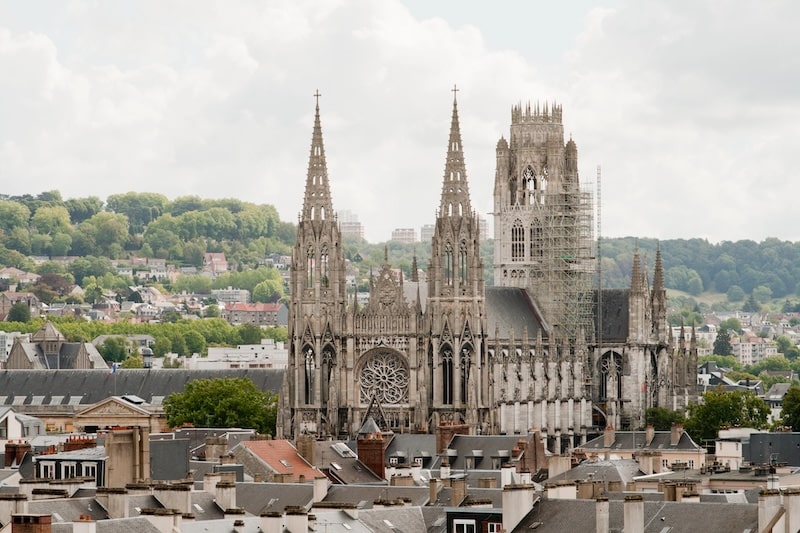
The first religious building here dates back to the dawn of Christianity, in the 4th century CE, and while we don’t really know what it looked like then, we do know it was destroyed by Vikings in 841.
It was rebuilt in Romanesque style starting in 1030 but most of that is gone too, apart from a piece of the old wall on the left when you face the cathedral’s main entrance. And so it went, the cathedral ageing, being ransacked, struck by lightning, damaged by fire, raided during the French Revolution, rebuilt.
The latest damage came from the Allied bombings of Rouen in 1944 as they fought to repel the occupying Germans. As bombs fell on the city, a large part of the cathedral was destroyed. It would take a dozen years to restore it.
Resilient through it all, Notre-Dame de Rouen remains the city’s most prestigious monument, a major attraction that has lost none of its magnetism.
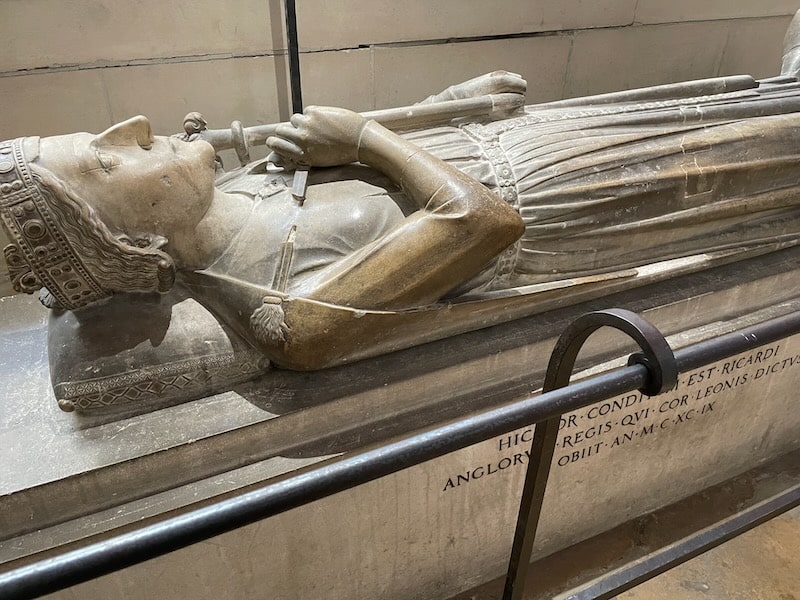 Tomb of Richard the Lionheart in Rouen's Cathedral ©OffbeatFrance/Leyla Alyanak
Tomb of Richard the Lionheart in Rouen's Cathedral ©OffbeatFrance/Leyla Alyanak2. Observe the façade of the cathedral as Monet did
If you’ve been to the Musée d’Orsay in Paris, you’ve undoubtedly seen some of Monet’s “Series of Rouen Cathedrals”. He painted 30, of which five are at the Orsay, and one is in Rouen, at the Museum of Fine Arts.
Monet was fascinated by light, and all you have to do is stand in front of the cathedral for a minute or two to understand what motivated him. Rouen’s weather changes quickly and can go from rain to summer sun almost instantly, at different times of day. The filigree-like façade of the cathedral accelerates that change as light bounces off the layers of carvings and its many sculptures.
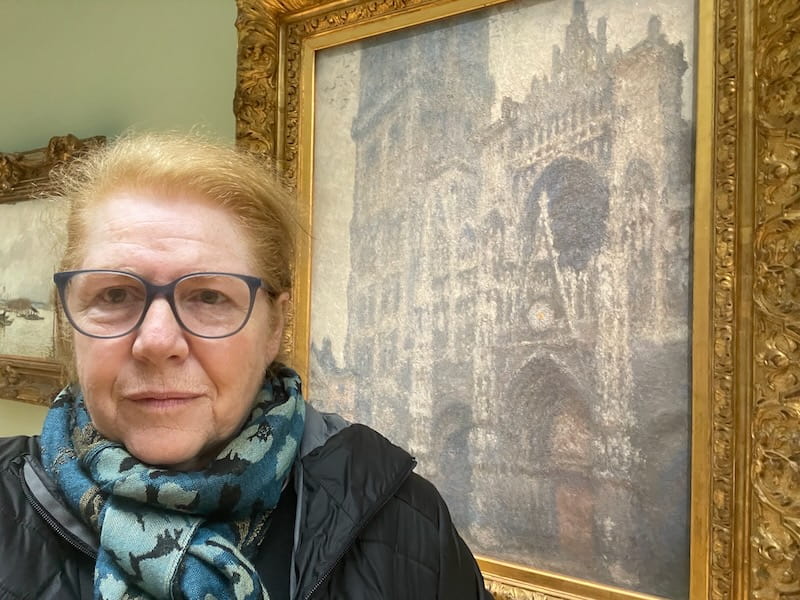 I couldn't resist the opportunity of being in the same frame as Monet
I couldn't resist the opportunity of being in the same frame as MonetHis paintings are one of the main reasons Rouen has become known as the “capital of Impressionism”.
3. Admire the impressive collection of Impressionist paintings at the Musée des Beaux-Arts
Monet wasn’t the only impressionist who painted Rouen: he just happened to be the most famous. Normandy being the 19th-century artists’ magnet it was, many others were taken by what they saw – like Sisley, Pissarro, Caillebotte, Renoir…
As a result, the museum now hosts the largest collection of Impressionists in France outside the Musée d'Orsay.
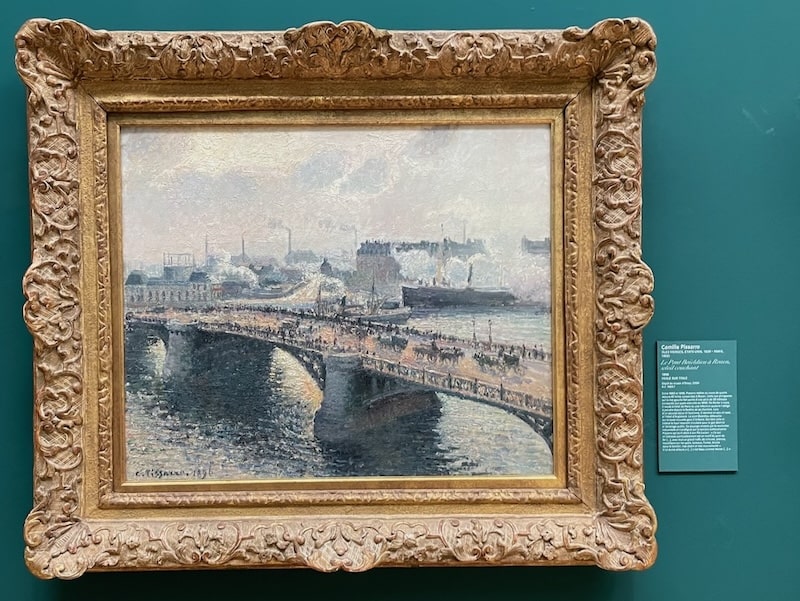
An impressionist current, the Ecole de Rouen, was born in the city, and the Fine Arts Museum displays several of its major representatives, including Joseph Delattre, Léon-Jules Lemaître, Charles Angrand and Charles Frechon. Not surprising, since the museum hosted the first impressionist collection outside Paris.
4. Relive the trials of Saint Joan of Arc at the Historial
Joan of Arc’s life was short-lived, a mere 19 years which came to abrupt halt here in Rouen, where she was tried and found guilty of heresy, witchcraft, and dressing like a man. She was burned at the stake within sight of La Couronne, France’s oldest inn, which was already standing in 1431 when Joan met her fate.
Joan of Arc, France’s patron saint, has left her mark on Rouen. Nearly 600 years after her death (she died in 1431), you can’t go anywhere in this city without seeing her name – on streets and squares and statues, but also on shop windows, as pastry names, or on plaques scattered throughout the city.
An intriguing monument to her is the Historial Jeanne d’Arc, a modern interactive museum that tells the story of her initial trial – and of her re-trial, which took place a quarter century after her death. That second trial would rehabilitate her, finding fault with the first tribunal, a story stunningly told with her own words from official transcripts of the time. Because visits are timed, you’d be wise to book your tickets early.
5. Stroll among Rouen’s 2000 half-timbered buildings
Rouen is home to nearly 2000 half-timbered houses (there were nearly 1000 more before the city’s partial destruction by bombs in 1944) so if you like medieval buildings and narrow cobblestone streets, take your time in Old Rouen’s preserved quarter.
See the white spaces between the wood frames?
These were traditionally filled with a mixture of clay, straw and animal dung, but were eventually replaced by plaster, brick or stone.
This half-timber technique, known as “colombage” in French, was highly practical. Wood was plentiful, and houses could be built quickly, often in relatively bright colors.
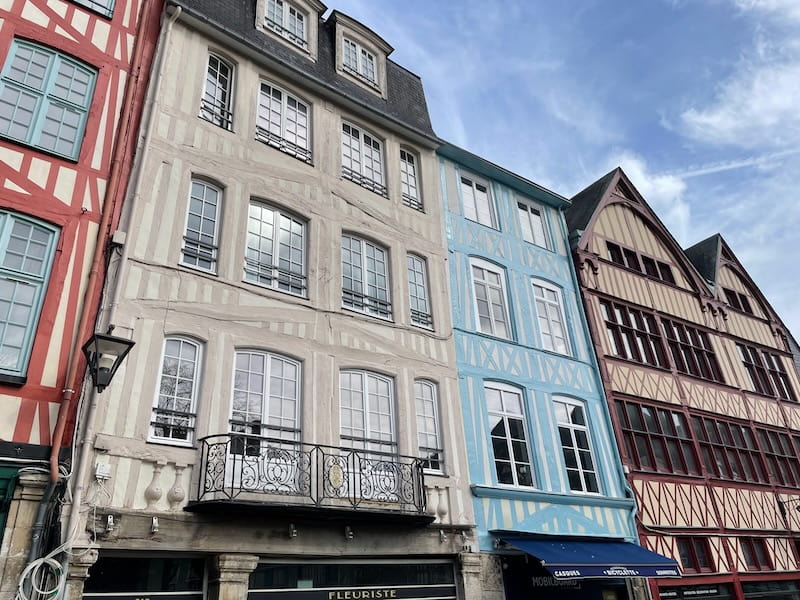 One of the many colorful half-timbered blocks in Old Rouen ©OffbeatFrance/Leyla Alyanak
One of the many colorful half-timbered blocks in Old Rouen ©OffbeatFrance/Leyla AlyanakYou might notice some houses jut out into the street above the ground floor. This is called “jettying” and was a technique used to protect lower walls from rainfall, but also to increase scarce living space for an expanding population, and sometimes to lower taxes, which were calculated on the basis of a dwelling's ground surface.
Some of the streets are so narrow they’re more passage than street, stretching silently from one street to the next, a bit like the famous traboules of Lyon. One of the last you can walk through is the tiny rue des Chanoines, because most of these have been closed off to all but residents.
So if you see an open door, take a peek.
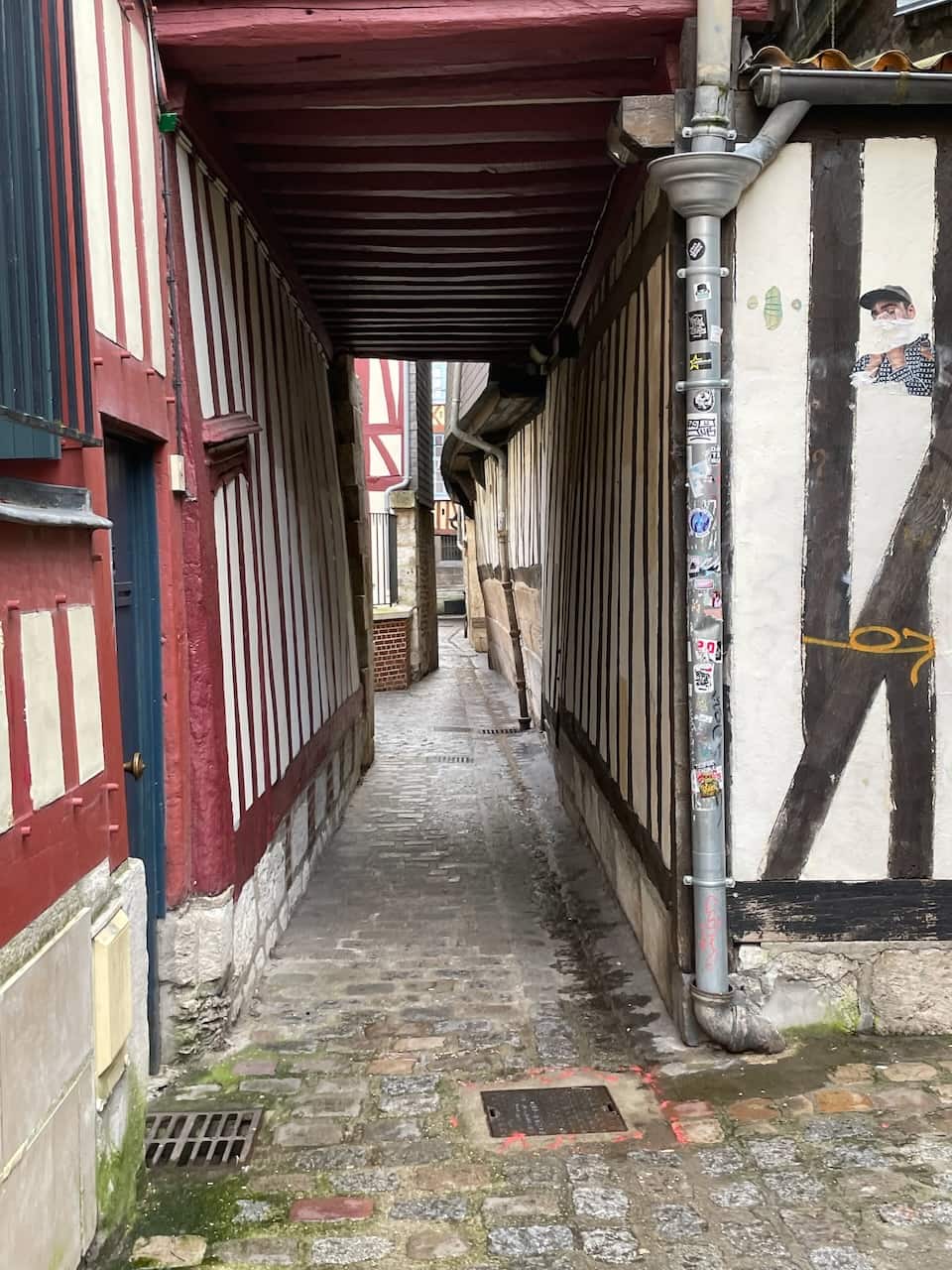 The tiniest little street! ©OffbeatFrance/Leyla Alyanak
The tiniest little street! ©OffbeatFrance/Leyla Alyanak6. Explore the culinary delights of this UNESCO City of Gastronomy
Rouen belongs to UNESCO’s Creative Cities Network, the only city in France included in the “gastronomy” category (and only one of seven French cities in any category).
The reason?
- Rouen’s culinary excellence and reputation
- Normandy’s produce diversity and excellence
- Its food festivals, especially the annual Fête du Ventre
- Its educational institutions (National Bakery Institute)
- The city’s many food-related health and sustainability initiatives
And that’s all the official stuff. But the food here is phenomenal. I didn’t have a bad meal during my stay. And I ate plenty (see restaurant recommendations at the bottom of this page), including walking into restaurants sight unseen, without looking things up on an app.
Here's a fun fact: Rouen has 650 restaurants for its population of around half a million, and 196 bars – it ranks third in France in terms of bars per capita!
7. Have lunch in a former ossuary once filled by plague victims
Speaking of food, and you may think this rather ghoulish, an unusual venue for lunch is hidden away in the Aître Saint-Maclou (from the Latin word “atrium”, which means central courtyard).
What’s unexpected is that the courtyard was once a cemetery and ossuary, a repository for the bodies of those who perished in various waves of the plague in Rouen. The poorest were thrown into a mass grave in the center, while the wealthier were buried under the various wings which they built to surround the mass grave.
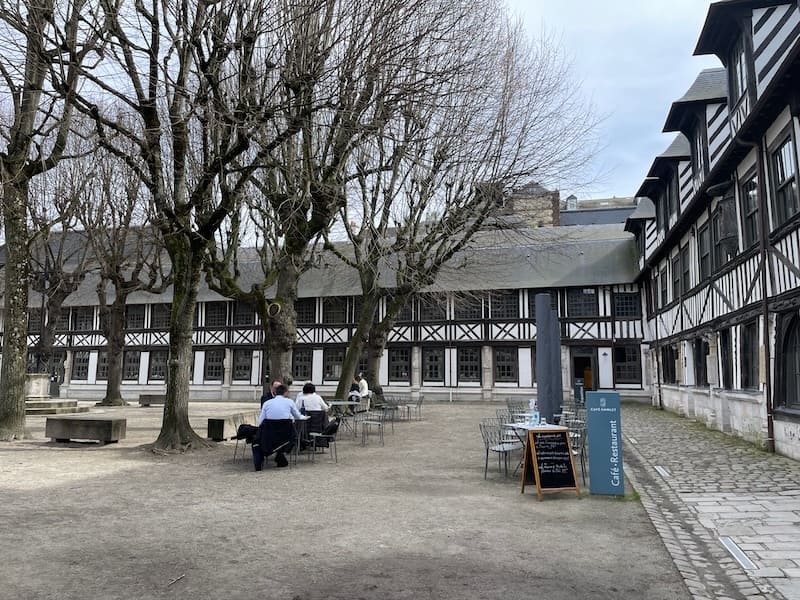 A casual lunch in the Aître Saint-Maclou ©OffbeatFrance/Leyla Alyanak
A casual lunch in the Aître Saint-Maclou ©OffbeatFrance/Leyla AlyanakToday, the atrium’s metamorphosis is complete. Not only is it the site of concerts and plays, but it is also home to the Café Hamlet, an intriguing little restaurant whose menu is the work of Gilles Tournadre, a Michelin-starred chef who handed back his stars in exchange for a less stressful life.
8. Enjoy the iconic meal Julia Child ate in France’s oldest inn, La Couronne
Equally odd in surroundings is La Couronne, if you think about it.
It is situated on the edge of the Place du Vieux Marché (Old Market Square), in full sight of the spot on which, in 1431, Joan of Arc was burned at the stake. (It is said that the rooms in the inn above it facing the square were full on the night she was put to death.)
But that’s not the claim to fame I want to talk about here.
It was Wednesday 3 November 1948 and July Child, who had docked in France just hours before, experienced what she called “the most exciting meal of my life”.
“It was an epiphany,” she said, in her book My Life in France. “In all the years since the succulent meal, I have yet to lose the feelings of wonder and excitement that it inspired in me. I can still almost taste it. And thinking back on it now reminds me that the pleasures of table, and of life, are infinite--toujours bon appétit!”
You, too, can experience Julia’s “epiphany” by sampling the Julia Child menu, which was popular at several tables the night I was there (I wanted to be different and tried an exquisite risotto with walnut emulsion…)
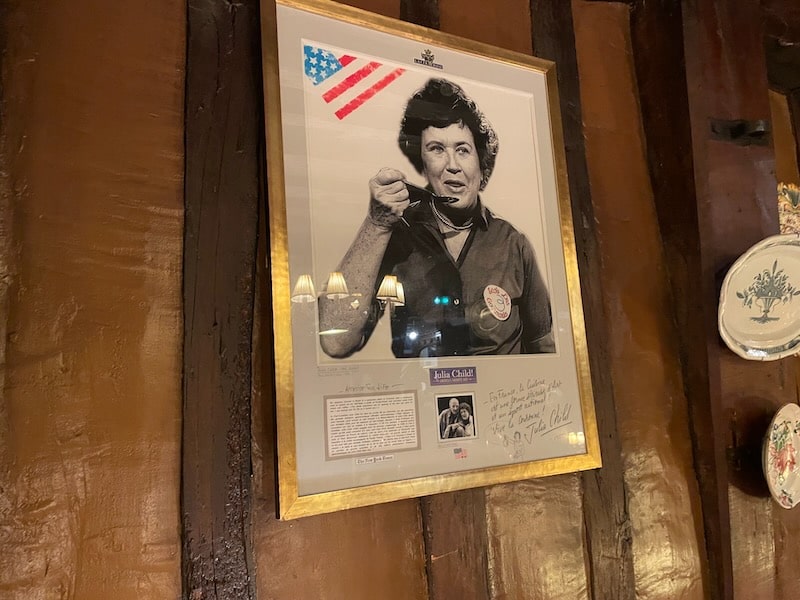 Julia Child ate here! ©OffbeatFrance/Leyla Alyanak
Julia Child ate here! ©OffbeatFrance/Leyla Alyanak9. Tell time with Le Gros Horloge
If you’ve ever seen a photograph of Rouen, there’s every chance it included the 14th-century Gros-Horloge, or Big Clock Tower, one of the oldest astronomical clocks in France. I think only the clocks in Cluny, Strasbourg and Lyon (read about it here) are older.
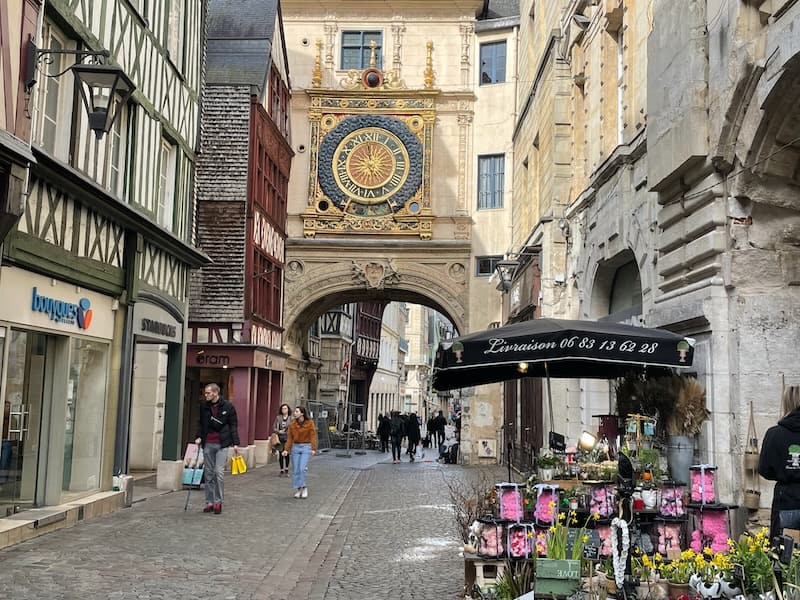 What the street of the Gros Horloge really looks like ©OffbeatFrance/Leyla Alyanak
What the street of the Gros Horloge really looks like ©OffbeatFrance/Leyla AlyanakThe first thing you’ll spot is the clock face and its single hour hand (yes, they only had one hand in the Middle Ages), a sun and moon to indicate the tides of this port city, the day of the week, and the lambs on the city’s coat of arms.
Around to the side, a fountain symbolizes the union between Rouen and the Seine River.
The best part is that you can go inside.
Climbing into the small square tower – which also housed the apartment of the clock’s Governor – you can see all the inner workings, including gears and bells.
Right at the very top, a tiny ledge (thankfully protected by a high parapet) opens up onto a spectacular view of Rouen.
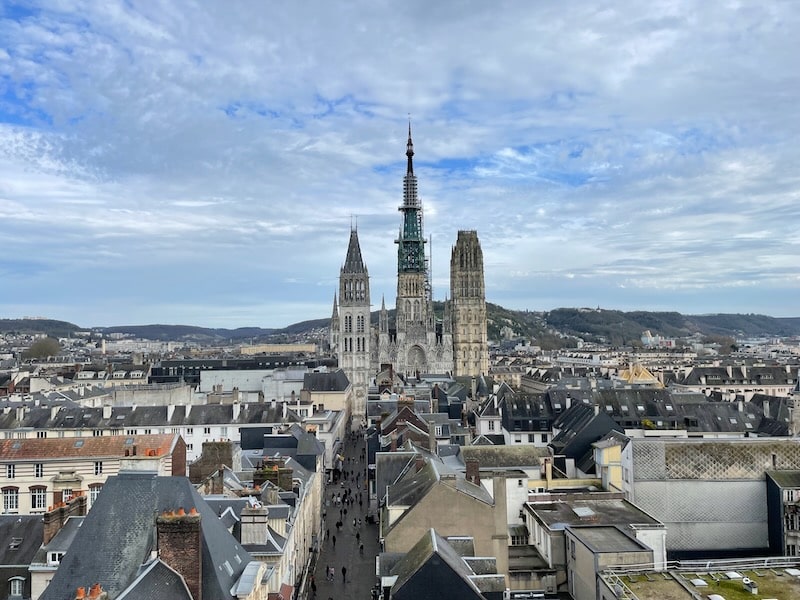 A view of the Rouen Cathedral from the top of the Gros Horloge ©OffbeatFrance/Leyla Alyanak
A view of the Rouen Cathedral from the top of the Gros Horloge ©OffbeatFrance/Leyla Alyanak10. Pay homage to the city's literary giants
Rouen also enjoys a healthy literary tradition as the home of 17th-century playwright Pierre Corneille, who wrote The Cid, and Gustave Flaubert, author of Madame Bovary.
You can visit the house in which Corneille was born, just off the Vieux-Marché square, and his “country home”, now the Corneille Museum, is a ten-minute drive from Rouen, in Petite-Couronne.
As for Flaubert, he spent his first 25 years in Rouen, much of it in a wing of the Hotel-Dieu, or hospital, where his father was head surgeon. The hospital, within walking distance of the Vieux-Marché, contains his room (closed to visits) but also a museum of the history of medicine.
11. Rummage through brocantes and antique shops
This visit is the easiest of them all: walk out your door, head for Old Rouen, and window shop. I don’t know if this is particular to Normandy but I was surprised at the number of antique shops scattered around the historic center… I wanted to enter every single one!
While you’ll find them throughout the old town, they’re concentrated about the Church of Saint-Maclou church along the rue Damiette.
12. Visit one of Rouen’s oddest museums, located in a former chapel
The first time I saw a photograph of this unusual museum, I knew I would have to visit. If I’m honest, this museum was probably what prompted me to go.
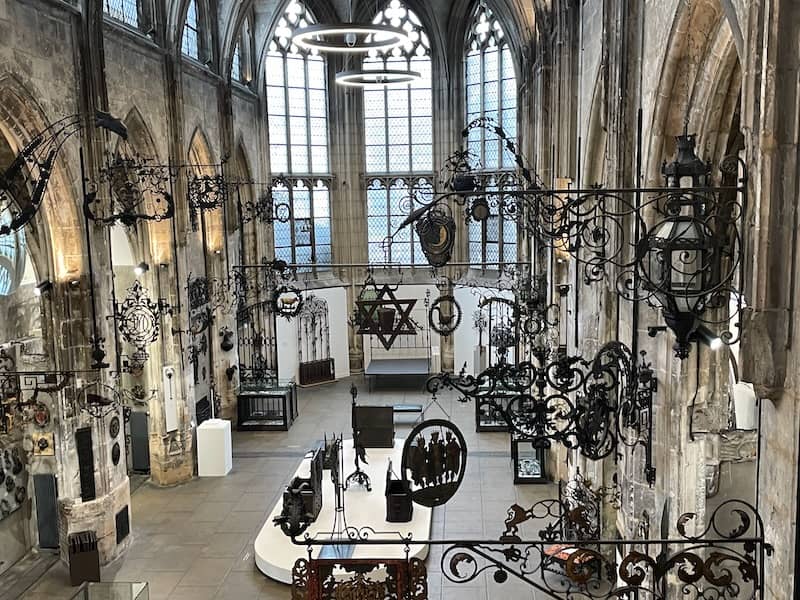 Looking down on the main exhibit room of the ironworks museum ©OffbeatFrance/Leyla Alyanak
Looking down on the main exhibit room of the ironworks museum ©OffbeatFrance/Leyla AlyanakWelcome to the Musée Le Secq des Tournelles, a wrought iron collection set in a disaffected church, the Eglise Saint-Laurent.
Founded more than 100 years ago, the museum’s unique ironworks come from Henri Le Secqu des Tournelles and his father and includes everything from architectural elements to slacks and tools and sewing accessories.
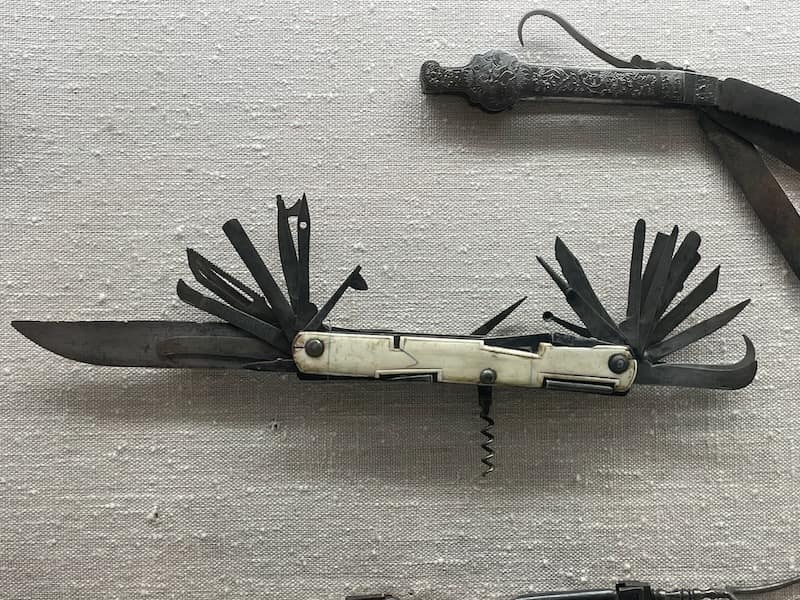 An early Swiss Army knife version? ©OffbeatFrance/Leyla Alyanak
An early Swiss Army knife version? ©OffbeatFrance/Leyla AlyanakHere’s an easy way to visit: Spend the morning at the Museum of Fine Arts of Rouen enjoying Monet. Then have lunch at In Situ around the corner, and finally, cross the street to the museum after lunch (it’s closed in the mornings).
If you like odd collections displayed with originality, you may not want to leave. I was stuck there for longer than planned when a thunderstorm made it difficult to leave – but certainly amplified the sense of mystery I felt inside.
...and a few other claims to fame
- The Maison Sublime, France's oldest Jewish monument, is located here (although you can only visit it via guided tour on Saturdays and I had left, so was unable to see it)
- Rouen is Western Europe's top cereal exporter
- its 12 city-owned museums are FREE
- it is home to the Armada, the world's largest tall-ship gathering
Getting to Rouen
Rouen is an easy day trip from Paris, whether by car or by train.
Rouen from Paris by car
Rouen is a two-hour drive from Paris, some 135km/84mi, along the A13 (although there are also other routes). Here are Michelin’s driving instructions.
If you don’t have your own car, you can check rental prices and availability here.
Rouen from Paris by train
Rouen by train is simple. Some 28 trains leave daily from St Lazare train station in Paris and the ride lasts about 1h40. Rouen-Rive Droite station, the main Rouen train station, is within walking distance of the old town. You can book your train here.
Places to eat in Rouen
Rouen is a delight for the palate]. I can recommend the following eateries:
- Café H'amlet, in the Aître Saint-Maclou
- Gill Pastry shop, with the same owners as the Café Hamlet, on the main street near the entrance of the Aître
- In Situ, around the corner from the Musée des Beaux-Arts. The chef, Laurent Blanchard, is a member of the Club des Toques de Rouen, a local culinary association which represents the city’s best chefs.
- Café Victor, if you’re ready to experience Canard à la Rouennaise, a world-famous local specialty of duck cooked in its own blood
- For some snacks, try the award-winning Fromagerie Jollit, also member of Club des Toques de Rouen, or Ma Boulangerie, whose chef Christophe Cressent is a Meilleur Ouvrier de France (the elite of France’s culinary scene, with extremely difficult entry requirements)
Where to stay in Rouen
I stayed at the Best Western Hotel Dieppe, right across the street from the train station. Super convenient, and home of the Café Victor, of Canard à la Rouennaise fame.
Other recommended hotels include:
- The Radisson Blu, also near the train station, with its renowned Le Jehanne restaurant
- The luxurious Bourg Theroulde, a Marriott property, right of the Place du Vieux-Marché
- The Best Western Flaubert literary hotel, around the corner from La Couronne restaurant
- If you’d rather stay in a budget apartment, this one is near the River Seine but still downtown
Before you go…
Going back in time, we shouldn't forget that as Rotomagus, Rouen was Gaul's second most important city (after Lugdunum, or Lyon).
But what has remained most visible are its medieval roots, which you'll spot throughout the old town. Do wander around on your own, or if you'd like to know the stories behind the places you see, take a guided tour and visit corners you might not otherwise see.
It's also a great city for eating, and has plenty of bike routes for those of you who need to burn off all that good food. I, on the other hand, was perfectly content with sitting in a café and watching the Rouennais go about their business.
Did you enjoy this article? I'd love if you shared it!
